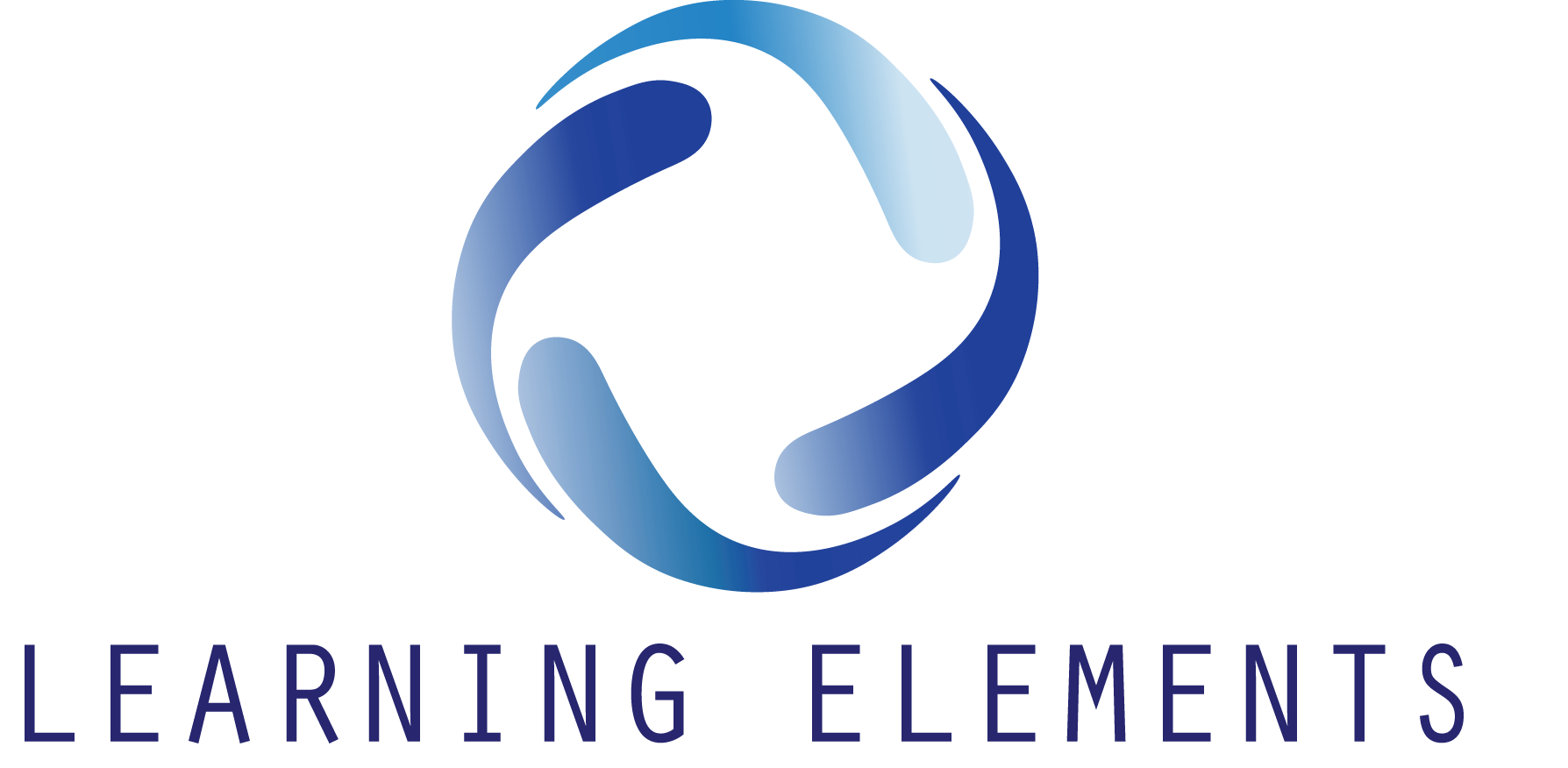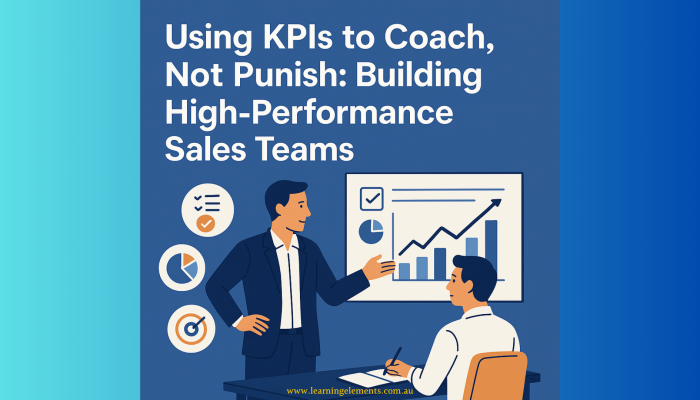Using KPIs to Coach, Not Punish: Building High-Performance Sales Teams
In today’s evolving sales nature, traditional performance management is no longer enough. It’s time to rethink how we’re using KPIs to coach—not as tools of pressure, but as instruments for empowerment!
Why Salespeople Often Fear KPIs, How Managers Should Reframe KPIs as Learning Opportunities
Sales teams are often under pressure. Targets, dashboards, and monthly numbers can start to feel like constant surveillance. For many salespeople, KPIs become a source of stress—used more to highlight failure than to support growth. But it doesn’t have to be this way.
This article explores how managers can flip the script and use KPIs as a tool for coaching and continuous improvement. With the right approach, data becomes a support system, not a weapon. It’s about building trust, improving performance, and creating a team that sees KPIs as a helpful part of their workflow.
Understanding KPIs in the Sales Context
Key Performance Indicators (KPIs) are the heartbeat of every high-functioning sales team. They offer measurable insights into how individuals and the broader team are tracking against business objectives. Common KPIs in sales include:
- Number of outbound calls made
- Revenue generated
- Sales conversion rates
- Pipeline growth
- Client retention rates
While these metrics are often tied to bonuses or performance reviews, KPIs shouldn’t exist solely to reward or punish. Instead, they should serve as a mirror—providing reflection and insights for growth.
When you’re using KPIs to coach, not to critique, the data becomes a source of growth. But used improperly, they can create fear, resistance, and high turnover.
The Common Misuse of KPIs: From Tool to Threat
(This highlights the risk of not using KPIs to coach with intention)
Too often, sales organisations fall into the trap of weaponising KPIs. When KPIs become punitive—used to single out underperformers or enforce rigid consequences—salespeople stop seeing them as helpful. They become disengaged, stressed, and less likely to collaborate.
Signs your team may be experiencing KPI misuse:
- Reps dread performance meetings
- Focus shifts to “gaming the system” instead of genuine efforts
- There’s little openness in 1:1 conversations
- Performance dips despite metric tracking
This culture fosters short-termism and burnout, especially when reps are held accountable for outcomes outside their control—like seasonal demand or lead quality.
The Psychology Behind Performance Coaching
Coaching rooted in psychology acknowledges that people perform best in supportive environments. Drawing on concepts like Carol Dweck’s growth mindset, coaching focuses on improvement, not perfection.
A strong coaching culture embraces:
- Constructive feedback: Frequent conversations, not annual appraisals
- Motivational drivers: Reps are more engaged when they feel autonomy, mastery, and purpose
- Resilience building: Helping reps learn from setbacks and maintain momentum
When viewed this way, KPIs become a guide on the learning journey, not a disciplinary tool.
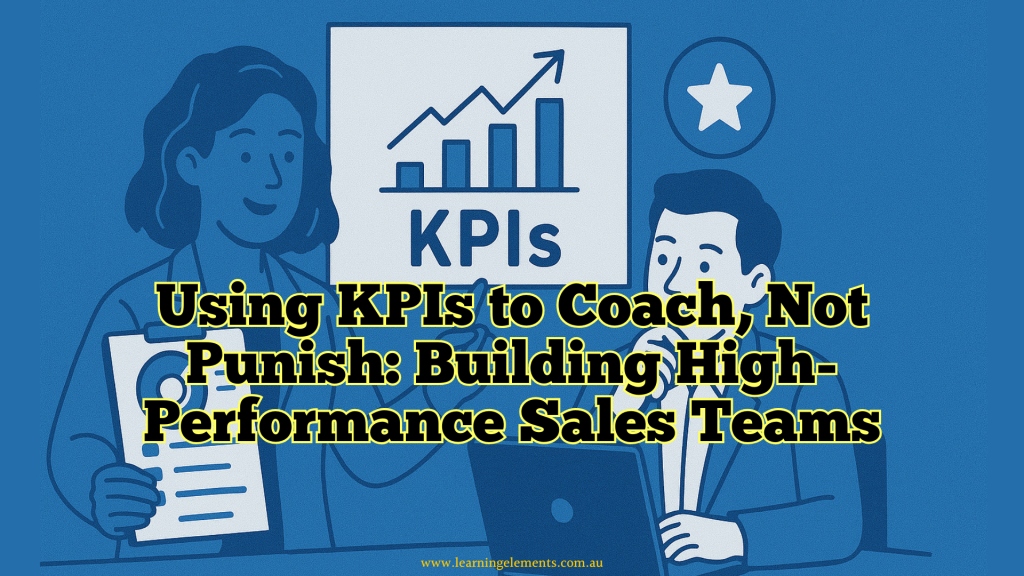
KPIs as a Coaching Tool, Not a Punishment
KPIs should act like road signs—showing progress and pointing to where support is needed. They aren’t meant to be hammers. When managers use KPIs to start conversations instead of end them, coaching becomes much easier.
For example, if a rep is struggling with conversion rates, a good manager doesn’t just point it out—they dig into the why. Is the messaging off? Is the targeting misaligned? This transforms the KPI into a problem-solving tool, not a blame game.
A mindset of using KPIs to coach begins with how we interpret the data.
Ready to turn KPIs into a coaching advantage? Explore our training programs designed for modern sales teams.
Reframing KPIs as Development Tools
Leaders must shift their language from “why did you miss this?” to “what can we learn from this?”
| Punitive KPI View | Developmental KPI View |
|---|---|
| “You didn’t hit target.” | “What trends can we spot over time?” |
| “You only closed 3 deals.” | “What worked in those 3? Let’s repeat.” |
| “You failed to follow up.” | “How can we improve follow-up systems?” |
This approach builds psychological safety and encourages reps to view feedback as a pathway to improvement rather than judgement.
Choosing the Right KPIs for Sales Coaching
Not all KPIs are created equal. Choose metrics that are:
- Actionable – Controlled by the rep’s efforts
- Balanced – A mix of leading (input) and lagging (output) indicators
- Aligned – Support team goals and company vision
Examples of Coaching-Friendly KPIs:
- Leading Indicators: Discovery calls made, LinkedIn outreach, proposals sent
- Lagging Indicators: Deals closed, win rates, average deal size
Avoid vanity metrics like social likes or impressions—unless they lead directly to sales engagement.
Implementing KPIs with a Coaching Lens
Embedding coaching into your KPI culture means rethinking how and when data is discussed.
Weekly Check-Ins and Progress Conversations
Short, consistent meetings help:
- Track small wins and early signs of progress
- Adjust targets as needed
- Keep morale high by celebrating effort
Using KPIs to Spot Coaching Opportunities
Look at KPI trends to identify:
- Skill gaps (e.g., lots of meetings, poor conversions)
- Training needs (e.g., resistance during objection handling)
- Underused strengths (e.g., reps who close more with fewer leads)
RELATED READ:
- Training Gaps and Objectives
- Training Needs Assessment Solutions and Steps by Learning Elements Team
- Benefits of Conducting a Training Needs Analysis
Monthly KPI Review Rhythm
A structured review rhythm helps make KPIs less threatening and more useful. Monthly check-ins give teams space to reflect, learn, and adjust. These meetings should be consistent, short, and focused.
The point isn’t to go through every metric, but to focus on the KPIs that matter most to current team goals. Keep the tone collaborative—not about “what went wrong?” but about “what can we do better?”
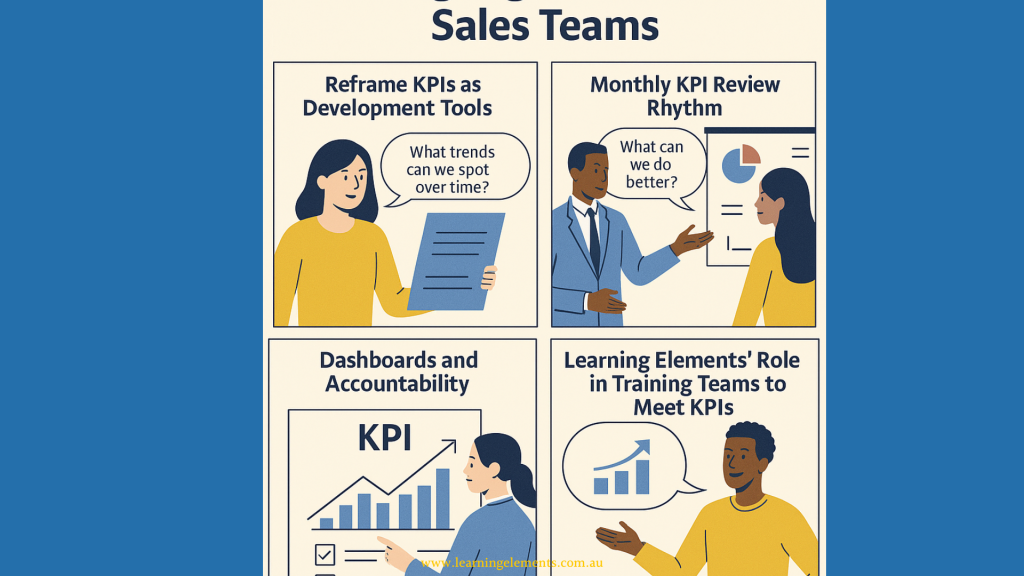
Dashboards and Accountability
Dashboards are helpful—if they’re built and used the right way. Reps should know what they’re looking at and why it matters. Managers should make sure dashboards are simple, relevant, and visible.
More importantly, dashboards should be part of a shared conversation, not a monitoring tool. It’s better when reps are involved in interpreting the data and thinking through next steps. That’s where real accountability begins.
Want support in setting up a monthly KPI coaching rhythm? Contact us today to learn how Learning Elements can guide your transformation.
Learning Elements’ Role in Training Teams to Meet KPIs
At Learning Elements, we train sales leaders and their teams to understand, track, and act on KPIs effectively. Our approach focuses on clarity, coaching, and continuous improvement. We help teams turn KPIs into something actionable—something that supports development instead of policing it.
From custom workshops to one-on-one coaching support, we offer tools that align sales strategy with measurable outcomes. And most importantly, we teach leaders how to have better performance conversations driven by data.
RELATED READ:
Want more insight on selecting and tracking the right metrics for your team? Read our Sales KPIs That Drive Growth: A Practical Guide for Business Leaders.
Role of Sales Leaders in KPI Coaching Culture
Sales leaders must act as coaches, not bosses. This means developing emotional intelligence and communication skills, including:
- Empathetic listening
- Data storytelling
- Joint goal setting
- Sharing vulnerability – Admit your own learning moments to foster openness
Creating a KPI-Friendly Culture of Transparency and Trust
It’s not about numbers—it’s about what the numbers mean.
Key cultural traits include:
- Psychological safety – Reps feel safe discussing struggles
- Open data access – Reps track their progress in real time
- Celebrating effort – Recognise consistent outreach or improvement, not just end results
Common Pitfalls to Avoid When Coaching with KPIs
Beware of these traps:
- Over-reporting: Time spent on admin kills productivity
- Micromanagement: Undermines trust and innovation
- One-size-fits-all goals: Disregards context like territory or market maturity
Coaching is most effective when contextualised and flexible.
Case Study: A Real Sales Team Turnaround Using Coaching KPIs
Case Study 1: SaaS Firm
In one of our internal engagements with a Sydney-based SaaS firm, we introduced leading indicators, co-created KPIs with reps, and trained managers in active listening—leading to a 38% increase in revenue and 40% rise in rep retention within six months. Similar strategies have delivered 30%+ revenue uplift in other SaaS firms. (Learning Elements)
What changed:
- Leading indicators added to coaching conversations
- Managers trained in active listening and coaching frameworks
- KPI benchmarks co-created with reps
What happened next:
- 38% revenue increase within 6 months
- 40% rise in rep retention
- A measurable lift in collaboration and self-leadership
Case Study 2: SaaS Sales Team
A SaaS marketing solutions provider struggled with 60–70% conversion rates. Sales felt training was a critique, not a boost.
What changed:
- Introduced one-on-one coaching sessions
- Focus shifted from “poor skills” to “affirming existing strengths”
- Emphasised personalised development
What happened next:
- Within three months, 80% of reps hit their targets (up from ~0%)
- Increased internal promotions and confidence (Mysalescoach.com)
Technology Tools That Support KPI-Based Coaching
The right tools make using KPIs to coach seamless and data-rich. Modern coaching thrives on the right digital tools:
Top picks include:
- Salesforce – Custom dashboards with coaching notes
- Ambition – Gamifies KPI progress
- Gong.io – Analyses sales calls for performance coaching
- Asana or Trello – Tracks personal coaching goals
Training Sales Managers to Use KPIs Effectively
At Learning Elements, we train sales leaders and teams to understand, track, and act on KPIs with clarity. Our programs focus on:
- Data interpretation
- Performance coaching techniques
- Leading coaching-based reviews
- Creating actionable development plans
We offer everything from custom workshops to 1:1 coaching support, helping teams turn KPIs into real conversations about growth.
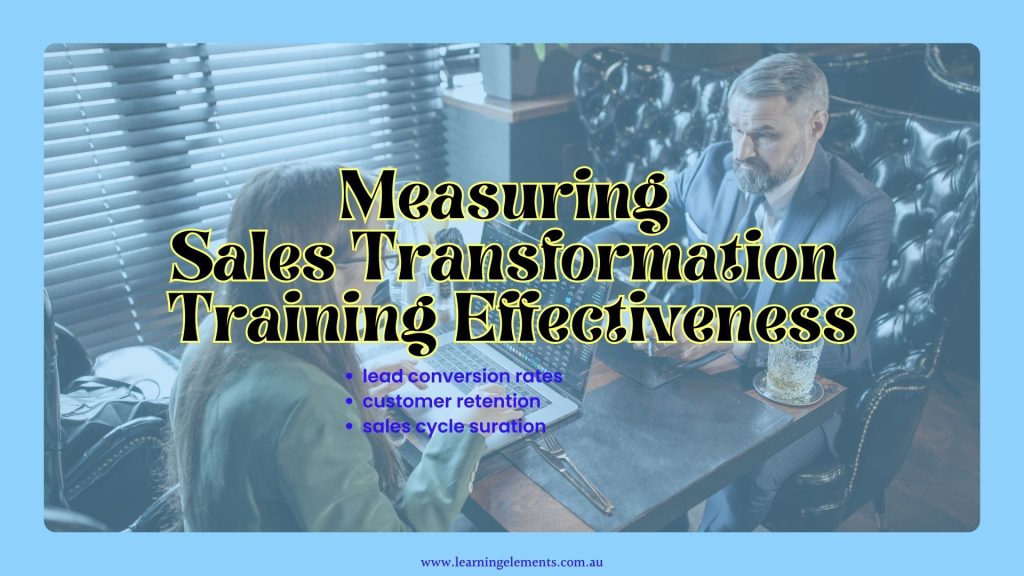
Measuring the Success of KPI-Driven Coaching Programs
To track success, consider these KPIs:
- Revenue growth and win rates
- Employee engagement and NPS
- Internal promotions
- Onboarding efficiency
- Rep satisfaction survey scores
These outcomes help prove the ROI of coaching cultures.
The Long-Term Impact of Coaching vs Punishing KPI Cultures
Over time, a coaching-first approach leads to:
- Increased rep engagement
- Sustained performance improvements
- Stronger employer branding
- Team loyalty and lower churn
When reps feel trusted—not watched—they perform their best.
FAQs
1. What are the best KPIs for coaching sales reps?
The best KPIs are actionable and developmental—like calls made, opportunities created, and client touchpoints. They highlight effort and identify coaching moments.
2. How often should KPIs be reviewed with reps?
Weekly or fortnightly check-ins work well. They prevent surprises and build consistent momentum without overwhelming reps.
3. Should low KPI performers be put on performance plans?
Not immediately. Use KPIs to identify challenges and offer coaching first. Performance plans should be a last resort, not a first response.
4. How can I make KPIs less intimidating for my team?
Involve reps in setting goals, frame KPIs as growth tools, and lead by example. Celebrate learning as much as results.
5. What if a rep consistently ignores KPIs?
Explore why—it may be a clarity, capability, or motivation issue. Then offer targeted support. If unaddressed, it may require stronger intervention.
6. Do all teams need the same KPIs?
Not at all. Tailor KPIs to team roles, goals, and sales cycles. What works for an SDR team may not work for account managers.
Conclusion
“Using KPIs to Coach, Not Punish: Building High-Performance Sales Teams” isn’t just a catchy phrase—it’s a powerful strategy to unlock sales excellence. When KPIs are used with empathy, intention, and development in mind, they become more than numbers. They become a compass.
By shifting from a fear-based model to a coaching-led one, your sales team doesn’t just hit targets—they exceed them, together.
